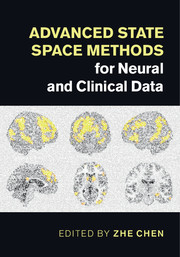Book contents
- Frontmatter
- Contents
- List of contributors
- Preface
- Introduction
- Inference and learning in latent Markov models
- Part I State space methods for neural data
- State space methods for MEG source reconstruction
- Autoregressive modeling of fMRI time series: state space approaches and the general linear model
- State space models and their spectral decomposition in dynamic causal modeling
- Estimating state and parameters in state space models of spike trains
- Bayesian inference for latent stepping and ramping models of spike train data
- Probabilistic approaches to uncover rat hippocampal population codes
- Neural decoding in motor cortex using state space models with hidden states
- State space modeling for analysis of behavior in learning experiments
- Part II State space methods for clinical data
- index
- References
State space modeling for analysis of behavior in learning experiments
from Part I - State space methods for neural data
Published online by Cambridge University Press: 05 October 2015
- Frontmatter
- Contents
- List of contributors
- Preface
- Introduction
- Inference and learning in latent Markov models
- Part I State space methods for neural data
- State space methods for MEG source reconstruction
- Autoregressive modeling of fMRI time series: state space approaches and the general linear model
- State space models and their spectral decomposition in dynamic causal modeling
- Estimating state and parameters in state space models of spike trains
- Bayesian inference for latent stepping and ramping models of spike train data
- Probabilistic approaches to uncover rat hippocampal population codes
- Neural decoding in motor cortex using state space models with hidden states
- State space modeling for analysis of behavior in learning experiments
- Part II State space methods for clinical data
- index
- References
Summary
Introduction
During the process of learning the brain undergoes changes that can be observed at both the cellular and systems level. Being able to track accurately simultaneous changes in behavior and neural activity is key to understanding how the brain learns new tasks and information.
Learning is studied in a large number of experimental paradigms involving, for example, testing effects on learning of brain lesions (Whishaw & Tomie 1991; Dias et al. 1997; Dusek & Eichenbaum 1997; Wise & Murray 1999; Fox et al. 2003; Kim & Frank 2009; Kayser & D'Esposito 2013), attentional modulation (Cook & Maunsell 2002; Hudson et al. 2009), optogenetic manipulation (Warden et al. 2012) and pharmacological interventions (Stefani et al. 2003). Studies are also performed to understand how learning is affected by aging (Harris & Wolbers 2012), stroke (Panarese et al. 2012) and psychological conditions including autism (Solomon et al. 2011) and synesthesia (Brang et al. 2013). The learning process is also studied in relation to changes in neural activity in specific brain regions (Jog et al. 1999; Wirth et al. 2003; Suzuki & Brown 2005; Brovelli et al. 2011; Mattfeld & Stark 2011).
In most cases, the response accuracy of a subject is binary, with a one representing a correct response and a zero representing an incorrect response. In its raw form, binary response accuracy can be difficult to visualize, especially if the time series is long, and the exact time when learning occurs can be difficult to identify. Typically, an experimenter is interested in deriving two things from the learning data: a learning trial and a learning curve. The first item is the time point at which responses significantly change relative to a baseline value such as chance performance. The second is estimation of a curve that defines the probability of a correct response as a function of trial. From these estimates, it is possible to compare changes in learning with other measurements such as, for example, localized brain oxygen consumption (via fMRI) or electrical activity.
Information
- Type
- Chapter
- Information
- Advanced State Space Methods for Neural and Clinical Data , pp. 231 - 254Publisher: Cambridge University PressPrint publication year: 2015
